I mentioned yesterday the new case in the High Court of England and Wales regarding software patents, Symbian Ltd v Comptroller General Of Patents. Symbian Ltd is a UK company which produces a mobile operating system, and in 2004 made a PCT application for "Mapping of dynamic link libraries in computer devices". The title itself should give a hint as to its potential validity, as DLLs are at the heart of a computer's functionality. The patent has been awarded by the European Patent Office (EP1678608), but it was rejected by the UKIPO (GB0325145.1). The patent is currently in the application stages at the USPTO. The abstract reads:
"A dynamic link library (DLL) in a computing device is provided in the form of a first part and an extension part. The first part has selected entry point ordinals by which an application program may link to first functions. The application program may only link to further functions via the extension part of the DLL."
I have read the application, and I must be missing something, but this does not seem to meet patentability requirements. Symbian seems to be saying that they have found a new way to link DLLs so that it will improve performance and interoperability. How does this amount to an inventive step? Moreover, the practice both in the UK and at the UKIPO has been to award patents only to software that offers an advance in the state of the art, which this invention fails (at least in my uneducated and opinionated view).
Symbian appealed the application rejection by the UK Intellectual Property Office, and the ruling makes for some interesting reading. Firstly, we get a re-run of the case law in this area. Then, we get yet another convoluted reasoning to assume that Art 52 of the EPC does not say what it clearly says, namely, that computer programs as such are not inventions, and therefore not patentable. The ruling then goes on to apply
Aerotel's test. Software patent geeks will know this by heart. The test says:
1. Construe the claim
2. Identify the actual contribution
3. Ask whether it falls solely within the excluded subject matter
4. Check whether the actual or alleged contribution is actually technical in nature
Patten J goes through the first three steps of the case, but forgets completely to answer the fourth! Patten J first construes the claim:
"This is not a problem in the present case. As explained earlier, the substance of the claim is the re-organisation of the DLL into two parts and the provision of a library interface for the extension DLL so as to improve the linking of any EXE program running on the computer with the available functions contained in the DLL files. No issues of construction arise."
Then he identifies the contribution:
"Symbian's case before the Hearing Officer was that the contribution made by the invention lay in the improved reliability of a computing device enabled by the provision of a novel interface. This enabled the EXE program to access available functionality regardless of additions or amendments made by the updates to the DLL and its ordinal numbers. "
Then he wonders if the contribution is excluded software matter (in other words, whether or not it is "software as such"):
"So is this invention no more than the running of the program? Having regard to the earlier authorities the answer has to be that it depends on what the program does and not merely how it does it. The mere fact that it involves the use of a computer program does not exclude it [...] The key elements in her reasoning appear to be that the use of the new interface to obtain better linking between the EXE program and the updated DLL does not involve a change in the role of the DLL but only in the way in which it is accessed in the new piece of software. This is nothing more than a computer program and is therefore, she decided, excluded from patentability. "
This is going well. He recognises that the application was rejected because it was software as such. He then goes on to agree that step 4 may not always be needed if the test falls at steps 2 or 3. In this particular case, the UKIPO has considered it to have failed at 3, as it is clear that DLLs are "software as such", and therefore should not be patentable software matter. I happen to agree with the UKIPO's interpretation. Unfortunately, Patten J has clearly hit his knowledge wall when it comes to software, and then rambles on about whether or not DLLs and operating systems are separate entities and should be considered as software (heavy theoretical Information Systems stuff coming from an English judge, ugh!). Patten J then delivers the single-most uninformed sentence with regards to software that I have ever read. He says:
"It is simply inaccurate to label all programs within the computer as software and on that basis to regard them as of equal importance in relation to its functionality."
What? When? How? Software is simply "a set of statements or instructions to be used directly or indirectly in a computer to bring about a certain result". Computer programs are... exactly the same thing!
Unsurprisingly, the conclusion is disappointing. Patten J disagrees with the narrowness of the UKIPO analysis, bypasses step 4, and concludes as follows:
"I think that the Hearing Officer took too narrow a view of the technical effect of the invention and was wrong to exclude it from patentability on the basis that it amounted to no more than a computer program. The appeal will therefore be allowed."
This is strange, because if he considered that Symbian's application was indeed patentable subject matter, then he should have gone to test if it had a technical contribution. Technical contribution has been defined by the EPO Board of Appeals as some technical advance on the prior art in the form of a new result. I cannot possibly see how making DLLs run faster amounts to such.
Now I understand why the ruling is being appealed by the UKIPO.

 del.icio.us
del.icio.us







